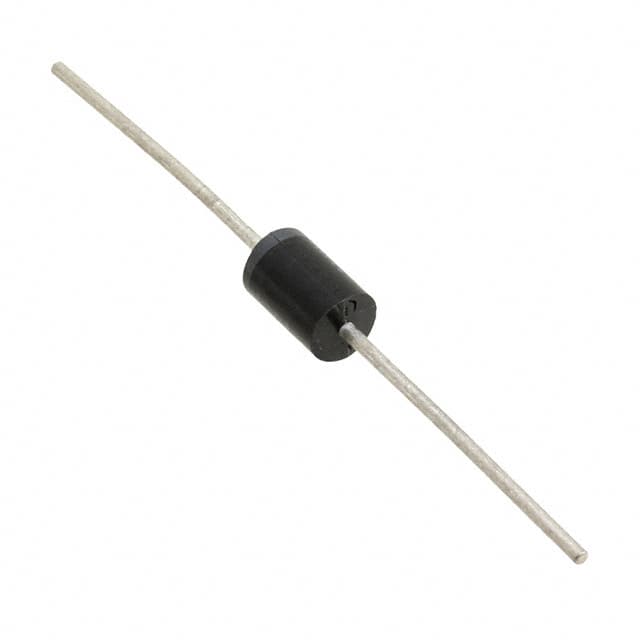MA5KP20CAE3 Product Overview
Introduction
The MA5KP20CAE3 belongs to the category of transient voltage suppressor (TVS) diodes and is commonly used for surge protection in electronic circuits. This entry provides a comprehensive overview of the MA5KP20CAE3, including its basic information, specifications, pin configuration, functional features, advantages and disadvantages, working principles, application field plans, and alternative models.
Basic Information Overview
- Category: Transient Voltage Suppressor (TVS) Diode
- Use: Surge protection in electronic circuits
- Characteristics: Fast response time, high surge capability, low clamping voltage
- Package: DO-201AD
- Essence: Protection against transient overvoltage events
- Packaging/Quantity: Available in reels or bulk packaging
Specifications
- Voltage - Reverse Standoff (Typ): 17.1V
- Voltage - Breakdown (Min): 18.9V
- Voltage - Clamping (Max) @ Ipp: 27.6V
- Current - Peak Pulse (10/1000µs): 34.4A
- Power - Peak Pulse: 5000W
- Type: Zener
Detailed Pin Configuration
The MA5KP20CAE3 TVS diode has a standard DO-201AD package with two leads. The pin configuration is as follows: - Pin 1: Anode - Pin 2: Cathode
Functional Features
- Fast response time to transient overvoltage events
- High surge capability to protect sensitive electronic components
- Low clamping voltage to limit the voltage across the protected circuit
Advantages and Disadvantages
Advantages
- Effective surge protection for electronic circuits
- Fast response time ensures minimal damage to sensitive components
- High surge capability for reliable protection
Disadvantages
- May require additional circuitry for comprehensive overvoltage protection
- Higher cost compared to traditional diodes
Working Principles
The MA5KP20CAE3 operates based on the principle of avalanche breakdown. When a transient overvoltage event occurs, the TVS diode rapidly conducts current, diverting the excess energy away from the protected circuit. This action helps to limit the voltage across the circuit, preventing damage to sensitive components.
Detailed Application Field Plans
The MA5KP20CAE3 is widely used in various applications requiring surge protection, including: - Power supply units - Communication equipment - Industrial control systems - Automotive electronics - Consumer electronics
Detailed and Complete Alternative Models
Some alternative models to the MA5KP20CAE3 TVS diode include: - 1. SMAJ20A: Similar surge protection capabilities with a different package type - 2. P6KE18CA: Lower power peak pulse rating but suitable for certain applications - 3. 5KP20A: Comparable surge protection characteristics with a different form factor
In conclusion, the MA5KP20CAE3 transient voltage suppressor diode offers effective surge protection with its fast response time, high surge capability, and low clamping voltage. Its application spans across various industries, and while it may have some disadvantages, its performance and reliability make it a popular choice for surge protection in electronic circuits.
Word Count: 443
قم بإدراج 10 أسئلة وإجابات شائعة تتعلق بتطبيق MA5KP20CAE3 في الحلول التقنية
What is MA5KP20CAE3?
- MA5KP20CAE3 is a transient voltage suppressor diode, commonly used to protect electronic circuits from overvoltage transients.
What is the maximum peak pulse power of MA5KP20CAE3?
- The maximum peak pulse power of MA5KP20CAE3 is 5000W.
What is the breakdown voltage of MA5KP20CAE3?
- The breakdown voltage of MA5KP20CAE3 is 20V.
How does MA5KP20CAE3 protect electronic circuits?
- MA5KP20CAE3 diverts excessive current away from sensitive components during voltage spikes or surges, preventing damage to the circuit.
In what type of technical solutions is MA5KP20CAE3 commonly used?
- MA5KP20CAE3 is commonly used in power supplies, telecommunications equipment, automotive electronics, and industrial control systems.
What are the key features of MA5KP20CAE3?
- MA5KP20CAE3 features low clamping voltage, fast response time, and high surge capability.
Can MA5KP20CAE3 be used for ESD protection?
- Yes, MA5KP20CAE3 can be used for electrostatic discharge (ESD) protection in various electronic devices.
What is the operating temperature range of MA5KP20CAE3?
- The operating temperature range of MA5KP20CAE3 is typically -55°C to 175°C.
Is MA5KP20CAE3 RoHS compliant?
- Yes, MA5KP20CAE3 is RoHS compliant, meeting the restriction of hazardous substances directive.
Where can I find detailed specifications and application notes for MA5KP20CAE3?
- Detailed specifications and application notes for MA5KP20CAE3 can be found on the manufacturer's datasheet or website.


